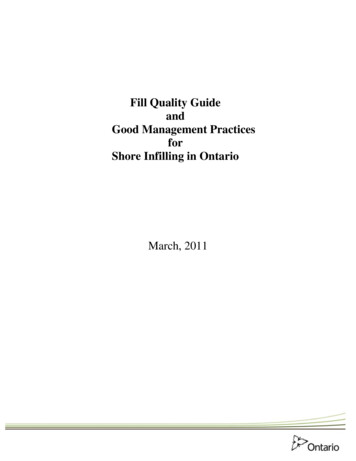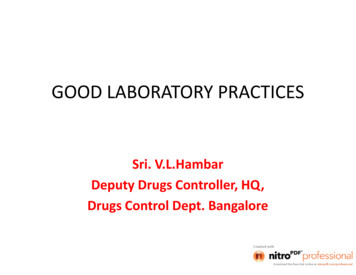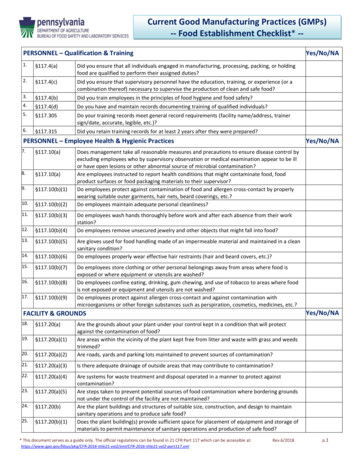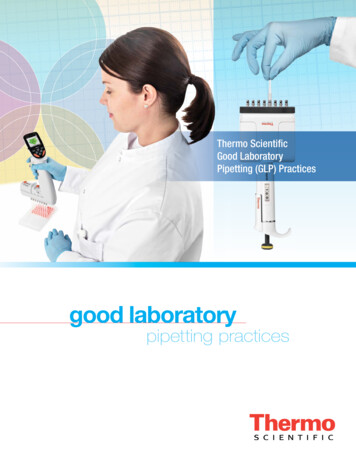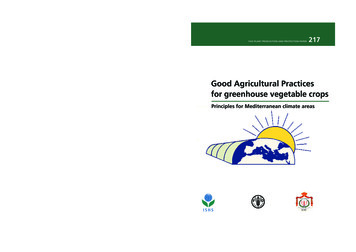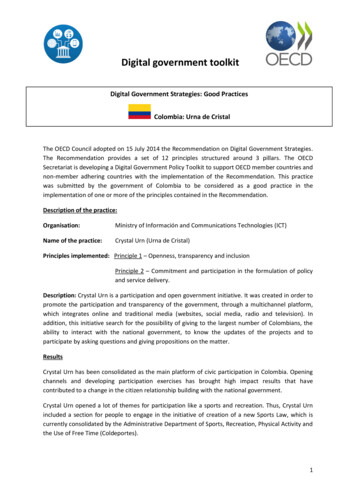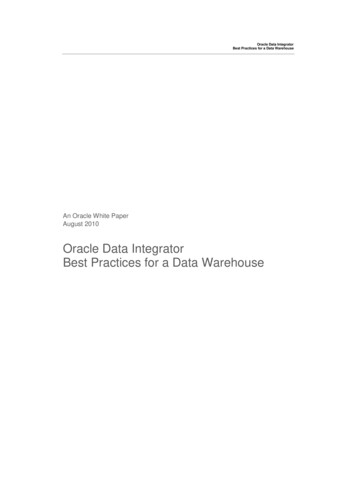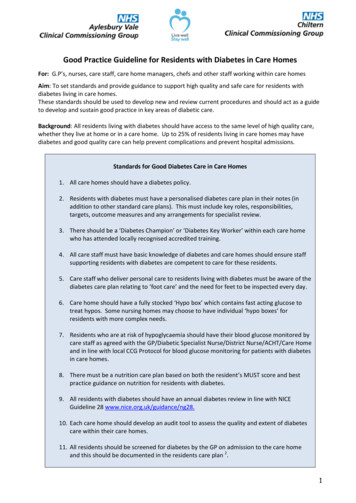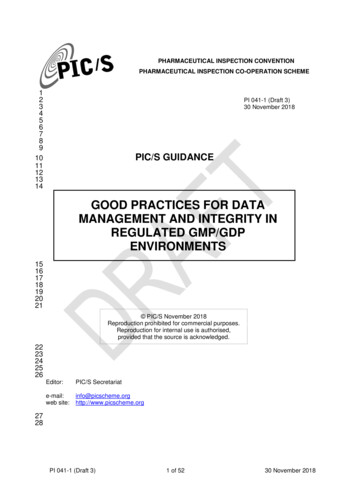
Transcription
PHARMACEUTICAL INSPECTION CONVENTIONPHARMACEUTICAL INSPECTION CO-OPERATION SCHEME1234567891011121314PI 041-1 (Draft 3)30 November 2018PIC/S GUIDANCEGOOD PRACTICES FOR DATAMANAGEMENT AND INTEGRITY INREGULATED GMP/GDPENVIRONMENTS15161718192021 PIC/S November 2018Reproduction prohibited for commercial purposes.Reproduction for internal use is authorised,provided that the source is acknowledged.2223242526Editor:PIC/S Secretariate-mail:web 8PI 041-1 (Draft 3)1 of 5230 November 2018
5455565758596061626364656667686970717273TABLE OF CONTENTSPage1.Document history . 32.Introduction . 33.Purpose . 44.Scope . 55.Data governance system . 55.1What is data governance? . 55.2Data governance systems . 55.3Risk management approach to data governance. 65.4Data criticality . 75.5Data risk . 75.6Data governance system review . 86. Organisational influences on successful data integrity management .86.1General . 86.2Code of ethics and policies. 96.3Quality culture .106.4Modernising the Pharmaceutical Quality System .116.5Regular management review of quality metrics .116.6Resource allocation .116.7Dealing with data integrity issues found internally.127. General data integrity principles and enablers .128. Specific data integrity considerations for paper-based systems .148.1Structure of the QMS and control of blank forms/templates/records .148.2Importance of controlling records .158.3Generation, distribution and control of template records .158.4Expectations for the generation, distribution and control of records .158.5Use and control of records located at the point of use .188.6Filling out records .188.7Making corrections on records .208.8Verification of records (secondary checks) .208.9Direct print-outs from electronic systems .228.10 True copies .228.11 Limitations of remote review of summary reports.238.12 Document retention .248.13 Disposal of original records .249.Specific data integrity considerations for computerised systems.259.1Structure of QMS and control of computerised systems .259.2Qualification and validation of computerised systems .269.3System security for computerised systems .339.4Audit trails for computerised systems .389.5Data capture/entry for computerised systems .409.6Review of data within computerised systems.419.7Storage, archival and disposal of electronic data .42PI 041-1 (Draft 3)2 of 5230 November 2018
7475767778798081828384858687889.889901Management of Hybrid Systems .4410. Data integrity considerations for outsourced activities .4510.1 General supply chain considerations .4510.2 Routine document verification .4510.3 Strategies for assessing data integrity in the supply chain .4611. Regulatory actions in response to data integrity findings .4711.1 Deficiency references .4711.2 Classification of deficiencies.4812. Remediation of data integrity failures .4912.1 Responding to significant data integrity issues .4912.2 Indicators of improvement .5013.Definitions .5114.Revision history.52DOCUMENT HISTORYAdoption by Committee of PI 041-1[Date]Entry into force of PI ONPIC/S Participating Authorities regularly undertake inspections of manufacturers anddistributors of Active Pharmaceutical Ingredient (API) and medicinal products inorder to determine the level of compliance with Good Manufacturing Practice (GMP)and Good Distribution Practice (GDP) principles. These inspections are commonlyperformed on-site however may be performed through the remote or off-siteevaluation of documentary evidence, in which case the limitations of remote reviewof data should be considered.2.2The effectiveness of these inspection processes is determined by the veracity of theevidence provided to the inspector and ultimately the integrity of the underlying data.It is critical to the inspection process that inspectors can determine and fully rely onthe accuracy and completeness of evidence and records presented to them.2.3Good data management practices influence the quality of all data generated andrecorded by a manufacturer and these practices should ensure that data isattributable, legible, contemporaneous, original, accurate, complete, consistent,enduring, and available. While the main focus of this document is in relation toGMP/GDP expectations, the principles herein should also be considered in the widercontext of good data management such as, data included in the registration dossierbased on which API and drug product control strategies and specifications are set.2.4Data Integrity is defined as “the extent to which all data are complete, consistent andaccurate, throughout the data lifecycle” 1 and is fundamental in a pharmaceuticalquality system which ensures that medicines are of the required quality. Poor dataintegrity practices and vulnerabilities undermine the quality of records and evidence,and may ultimately undermine the quality of medicinal products.2.5Good data management practices apply to all elements of the pharmaceutical qualitysystem and the principles herein apply equally to data generated by electronic andpaper-based systems.1MHRA GMP Data Integrity Definitions and Guidance for Industry March 2015PI 041-1 (Draft 3)3 of 5230 November 2018
1191201211221231242.6The responsibility for good practices regarding data management and integrity lieswith the manufacturer or distributor undergoing inspection. They have fullresponsibility and a duty to assess their data management systems for potentialvulnerabilities and take steps to design and implement good data governancepractices to ensure data integrity is 415515615715833.1PURPOSEThis document was written with the aim of:3.1.1Providing guidance for inspectorates in the interpretation of GMP/GDP requirementsin relation to good data management and the conduct of inspections.3.1.2Providing consolidated, illustrative guidance on risk-based control strategies whichenable the existing requirements for data integrity and reliability as described inPIC/S Guides for GMP 2 and GDP 3 to be implemented in the context of modernindustry practices and globalised supply chains.3.1.3Facilitating the effective implementation of good data management elements into theroutine planning and conduct of GMP/GDP inspections; to provide a tool toharmonise GMP/GDP inspections and to ensure the quality of inspections withregards to data integrity expectations.3.2This guidance, together with inspectorate resources such as aide memoire, shouldenable the inspector to make an optimal use of the inspection time and an optimalevaluation of data integrity elements during an inspection.3.3Guidance herein should assist the inspectorate in planning a risk-based inspectionrelating to good data management practices.3.4Good data management has always been considered an integral part of GMP/GDP.Hence, this guide is not intended to impose additional regulatory burden uponregulated entities, rather it is intended to provide guidance on the interpretation ofexisting GMP/GDP requirements relating to current industry data managementpractices.3.5The principles of data management and integrity apply equally to paper-based,computerised and hybrid systems and should not place any restraint upon thedevelopment or adoption of new concepts or technologies. In accordance with ICHQ10 principles, this guide should facilitate the adoption of innovative technologiesthrough continual improvement.3.6The term “Pharmaceutical Quality System” is predominantly used throughout thisdocument to denote the quality management system used to manage and achievequality objectives. While the term “Pharmaceutical Quality System” is usedpredominantly by GMP regulated entities, for the purposes of this guidance, it shouldbe regarded as interchangeable with the term “Quality System” used by GDPregulated entities.15916016116216316416516644.1SCOPEThe guidance has been written to apply to on-site inspections of those sitesperforming manufacturing (GMP) and distribution (GDP) activities. The principleswithin this guide are applicable for all stages throughout the product lifecycle. Theguide should be considered as a non-exhaustive list of areas to be considered duringinspection.4.2The guidance also applies to remote (desktop) inspections of sites performingmanufacturing (GMP) and distribution (GDP) activities, although this will be limited2PIC/S PE 009 Guide to Good Manufacturing Practice for Medicinal Products, specifically Part I chapters 4, 5, 6, PartII chapters 5, 6 & Annex 11PIC/S PE 011 Guide to Good Distribution Practice for Medicinal Products, specifically sections 3, 4, 5 & 63PI 041-1 (Draft 3)4 of 5230 November 2018
167168169170171172173174175176to an assessment of data governance systems. On-site assessment is normallyrequired for data verification and evidence of operational compliance withprocedures.4.3Whilst this document has been written with the above scope, many principlesregarding good data management practices described herein have applications forother areas of the regulated pharmaceutical and healthcare industry.4.4This guide is not intended to provide specific guidance for “for-cause” inspectionsfollowing detection of significant data integrity vulnerabilities where forensic expertisemay be required.1775DATA GOVERNANCE SYSTEM1785.1What is data 5.1.1Data governance is the sum total of arrangements which provide assurance of dataquality. These arrangements ensure that data,
2.4 Data Integrity is defined as “the extent to which all data are complete, consistent and 112 accurate, throughout the data lifecycle” 1 and is fundamental in a pharmaceutical 113 quality system which ensures that medicines are of the required quality. Poor data 114 integrity practices and vulnerabilities undermine the quality of records and evidence, 115 and may ultimately undermine the .
